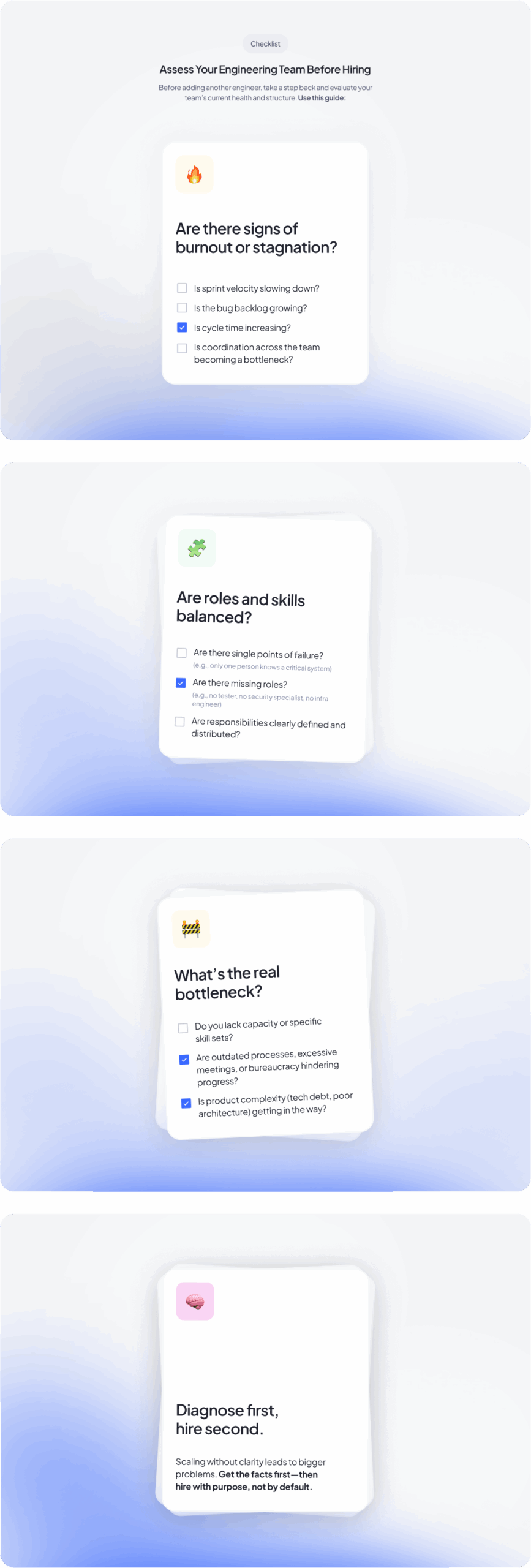You’ve got product-market fit. Users are growing, and so are feature requests. But your engineering team? Looks quite stretched thin. Truth be told, scaling a business means knowing how to scale engineering teams without compromising speed or code quality.
Ultimately, simply throwing more bodies at the problem can backfire. In fact, a higher number of engineers doesn’t always translate to increased output. Rapid growth often leads to communication bottlenecks and diminishing returns. Although scaling is about sustainable growth — maintaining quality, collaboration, and culture as you expand is more than just headcount.
In this post, we’ll break down how to scale engineering teams the right way — with performance, collaboration, and culture at the core — and what to do if you lack the internal HR bandwidth.
Scaling Is Not Just Hiring More Engineers
A common pitfall is believing that more developers = more velocity. In reality, simply doubling your dev headcount can lead to chaos. Imagine a startup that doubled its team in six months, only to watch sprint velocity plunge. This happens because added engineers mean more communication lines, more context-switching, and a heavier onboarding burden. Growth can actually expose or create bottlenecks unless you plan carefully.
The key is to distinguish growth from scaling. Growth (headcount or revenue) is easy to measure; scaling is a qualitative goal. Scaling means adding capacity sustainably, without losing quality or cohesion. For example, adding a dozen junior devs to fix bugs might increase short-term output, but if none are familiar with the codebase and processes, overall efficiency can drop. Instead, focus on maintaining velocity and quality metrics — only hire when you have processes and culture in place to integrate new team members effectively.
Let’s take a look at how to do it without harming your business.
Start by Assessing Your Current Engineering Team Structure

Before hiring one more engineer, evaluate your team’s health and structure. This is true whether you’re learning how to build an engineering team from scratch or optimizing an existing one. Ask:
- Are your engineers burned out or hitting plateaus? Track metrics like sprint velocity, cycle time, and bug backlog. If velocity is slipping or defects are piling up, there may be hidden problems. In large teams, coordination overhead can kill productivity.
- Are roles and skills balanced? Audit responsibilities. Do you have single points of failure (e.g., only one person knows a critical service)? Are there gaps (no tester, or no security specialist)? Identify missing skill sets: Maybe you need more infrastructure engineers or a data architect.
- What’s the root bottleneck? It could be people (simply not enough capacity or skills), process (outdated workflows, too many meetings), or product complexity (architectural debt or overly ambitious roadmap). Pinning this down determines the solution.
In summary, make a fact-based diagnosis of the current state before expanding. Only by understanding where the team is struggling can you plan how to help it scale, whether by reorganizing roles, improving processes, or, yes, adding capacity.
Set the Foundation: Culture, Processes, and Ownership

Before hiring or reorganizing, solidify your cultural and process foundations. In practice, this means clearly articulating values and norms. Do you prioritize ownership, continuous delivery, and code quality? Or rapid prototyping and experimentation? Whatever they are, make them explicit. Teams scale best when everyone “speaks the same language” of values.
Also implement scalable rituals and standards. Ensure practices like code reviews, retrospectives, and documentation aren’t ad-hoc. For example, invest in a structured code review culture so that quality is upheld as your team grows. Establish clear decision-making boundaries: when should a developer decide on a solution vs. escalate? Who has final say on tech stack or major architecture changes? Defining responsibility and “ownership” prevents confusion as teams divide.
- Core Values: Document your team’s core principles (e.g., transparency, customer focus, code craftsmanship). Regularly revisit them, especially as new hires join.
- Process Rituals: Standardize agile ceremonies (planning, standups, retros). Keep them lightweight but consistent.
- Documentation: Build a living knowledge base (wiki or Confluence) for architecture, onboarding guides, coding standards, and design docs. New team members can ramp up faster and avoid context loss.
By being deliberate about culture (not letting it form accidentally) and by codifying repeatable processes, you create a foundation that scales. Teams without this “intentional culture” often fragment or degrade in quality when they grow.
Optimize Before You Expand
Before adding more heads, streamline what you already have. Technical debt, inefficient toolchains, and overloaded schedules are growth killers. Use the breathing room to invest in these upgrades:

- Clean up technical debt. Schedule a “Fix the Debt” initiative where, for example, a month is dedicated to refactoring and improving existing code.
- Automate and refine processes. If you don’t have a solid CI/CD pipeline, build one. Automate testing and deployments. This not only makes life easier for current devs but means new hires can deploy with confidence too.
- Protect deep work. Meetings can be developers’ top distraction. Cut unnecessary calls and synchronous status meetings. Instead, encourage asynchronous updates (e.g., daily written standups in Slack or project tools). This will allow them to have more time for deep work.
Many startups rush to hire new developers without first asking, “Are we giving our current team the right environment to thrive?” By optimizing your toolchain and workflows first, you’ll acknowledge how many new devs you actually need without overhiring, and any future hires will have a cleaner codebase and faster feedback loops to jump into, making the whole team more productive.
Grow in Stages: Team Topologies That Work
As your team expands, adopt a scaling-friendly organization model rather than one big silo. Small, cross-functional teams (often called pods or squads) are proven to work well. For example, Spotify popularized the “squad” model: each squad is a tiny product team with all the skills (engineers, testers, designers, etc.) to own a feature end-to-end. They’re responsible for a specific aspect of the product and work collaboratively using shared backlogs. Likewise, Amazon’s famous “Two-Pizza Teams” rule suggests keeping groups under ~8 people (the size fed by two pizzas) for agility.

- Start generalist, then specialize. Early on, you may have full-stack developers handling everything. As you grow, transition into balanced feature teams: each team tackles certain product areas. This prevents silos while allowing expertise to develop.
- Autonomous pods. Ensure each team has an end-to-end mission (e.g., “mobile app notifications” or “checkout payments”). Grant them autonomy over code, infrastructure, and decisions for that domain. This keeps communication lines short internally and avoids coordination overhead.
- Avoid premature siloing. Don’t over-specialize too early (e.g. having separate teams for just “UI” or “API” if unnecessary). That can create handoff delays. Instead, aim for cross-functionality.
Choosing the right model (feature teams, component teams, or platform teams) depends on your product and stage. The key is gradual change: reorganize step by step rather than attempt a massive overhaul. By moving to cross-functional pods or squads, you preserve agility and shared ownership — hallmarks of high-performing engineering teams.
How to Build and Manage Remote Engineering Teams that Actually Work

If your scale involves distributed or fully remote teams (such as tapping LATAM talent from abroad), you need to set up remote work for success. Key principles include overlapping work hours, a “written culture,” and thorough onboarding.
- Overlap & Communication. Even when team members are scattered by time zone, schedule at least a few overlapping hours for live collaboration. Use video calls judiciously: they foster connection and allow to engage face-to-face, which can actually make wonders for productivity. Yet, remember what we’ve stated before, an async-first mindset preserves deep work hours.
- Document everything. In a remote setting, the only reliable record is written. Insist on up-to-date docs for architecture, standards, and onboarding. Use shared wikis or project-management tools (Jira, Notion, etc.) so anyone can catch up on context without pinging someone.
- Onboarding & Mentorship. For new hires (especially remote), build a structured onboarding plan. Provide checklists, training modules, and a designated mentor or “buddy” to answer questions. This dramatically cuts time-to-productivity.
- Foster psychological safety. Remote teams need extra effort to feel like a team. Encourage open communication (even casual chats where team members send memes), explicitly invite input from all members, and recognize every contribution. Make it clear that questions and mistakes are okay. This inclusive culture keeps collaboration healthy across distances and cultural gaps.
Building and managing a remote engineering team is a skill in itself. But with clear processes, overlap windows, and a culture of trust, distributed teams can operate as effectively as co-located ones.
And if you need more help assembling such a team, we can help you out. At BEON.tech, we specialize in building and managing high-performing remote engineering teams with top LATAM talent — fast, flexible, and tailored to your needs. We’ve helped fast-growing startups and companies listed on the NASDAQ scale efficiently without compromising quality or culture. Want to learn more? Just book a call.
Don’t Have a Full Recruiting Team? How to Build an Engineering Team with External Support
Not every high-growth startup has a full HR or recruiting department — and that’s okay. You can still scale smartly by partnering with specialized staffing or augmentation agencies. IT staff augmentation firms can serve as an “on-demand talent engine”:
- Speed through pre-vetted pools. Top agencies maintain networks of pre-screened engineers. Instead of wrestling with job boards, you tap into these pools of talent. This can dramatically shorten hiring time. Augmentation allows companies to onboard professionals in weeks or even days rather than months.
- Quality over quantity. A good agency vets not just skills but fit. They can filter for candidates experienced in your tech stack, timezone, and company size. This helps ensure new hires are productive immediately and mesh with your culture.
- Flexible scaling. Need 2 more devs this quarter, then 5 more next? Augmentation lets you scale up (or down) flexibly, avoiding long-term commitments. You pay for the resources you use, so there’s less risk if plans change.
- Cost and overhead savings. The agency handles sourcing, screening, and often benefits/admin for the augmented team. This frees your founders and existing leads to focus on product and team culture, not endless interviews.
In essence, IT staffing is not just for big corporations. It’s a viable strategy for startups needing to scale fast without a big recruiting arm. This model offers a high level of flexibility and access to pre-vetted expert developers from tech hubs around the world. If you don’t have bandwidth internally to figure out how to build and manage remote engineering teams, working with a specialized staffing agency can help you scale smarter.
Scale Your Engineering Team with Experts
Remember, scaling is primarily a leadership challenge, not just a recruiting sprint. By getting your structure, culture, and processes right first, adding team members becomes an enhancement, not a burden.
Overall, the path to sustainable growth starts by learning how to scale engineering teams with intention, structure, and the right support. If you’re looking to expand with elite IT talent and want a team that feels like part of your company, consider partnering with BEON.tech. We specialize in helping companies — including those listed on the NASDAQ — scale engineering teams with:
- Elite LATAM talent: Our developers are rigorously vetted through AI-powered technical assessments and psychometric testing—ensuring you gain access to the top 3% of candidates.
- Seamless integration: Engineers work within your U.S. time zones, adapt to your workflows, and align culturally from day one.
- Developer-first culture: With competitive compensation, growth paths, and wellness programs, we’ve earned #1 Great Place to Work for Millennials and the highest Glassdoor rating for IT staff augmentation.
- Fast, flexible onboarding: Interview candidates in under 48 hours and only pay once you hire. We handle compliance (including HIPAA), so you can scale with confidence.
Let’s scale smarter — together. Book a call to learn more.
Explore our
Machine Data vs Human Data: A Strategic Guide for AI Training
The rapid rise of AI applications — from customer service chatbots to sophisticated generative design tools — has placed data quality at the heart of AI development. While high-quality training data is essential for building reliable, high-performing models, not all data is created equal. Broadly, AI training datasets fall into two main categories: Each type…
Tech Recruitment in Brazil: The Expert Guide to Hiring Brazilian Tech Talent
Are you looking for the most promising countries to find top tech talent? If so, then you probably know Latin America is an attractive place to hire experienced, culture-fit candidates – and there’s one that stands out as a top performer. Yes, we’re talking about Brazil. As one of the fastest-growing economies worldwide, Brazil has…
The Complete Guide to Human Data for Code-Generating LLMs
Code-generating large language models (LLMs) are transforming software development. By automating repetitive coding tasks, assisting with debugging, and even generating functional code from simple prompts, these models allow development teams to work faster, more efficiently, and with greater focus on complex challenges. As businesses increasingly adopt AI-powered tools to streamline operations and reduce development cycles,…






